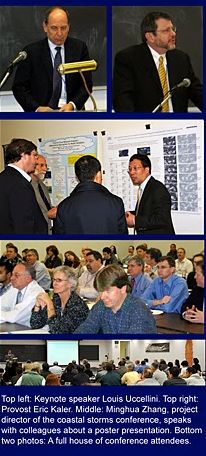 Over 120 people from academia, industry, non-profit organizations, and governmental agencies attended a SUNY Conversations-in-the Disciplines (CID) conference on coastal storms held on November 12-13. Participants convened to discuss recent advances in understanding the physics, impact, prediction, and future change of winter storms and hurricanes in the coastal region. The conference was part of a larger conference, “Changing Climates, Changing Minds,” an interdisciplinary event jointly organized by the School of Marine and Atmospheric Sciences, the Humanities Institute, and the Department of Philosophy.
Over 120 people from academia, industry, non-profit organizations, and governmental agencies attended a SUNY Conversations-in-the Disciplines (CID) conference on coastal storms held on November 12-13. Participants convened to discuss recent advances in understanding the physics, impact, prediction, and future change of winter storms and hurricanes in the coastal region. The conference was part of a larger conference, “Changing Climates, Changing Minds,” an interdisciplinary event jointly organized by the School of Marine and Atmospheric Sciences, the Humanities Institute, and the Department of Philosophy.
“The conference was a great success,” said Professor Minghua Zhang, Director of the Institute for Terrestrial and Planetary Atmosphere and Project Director of the SUNY CID. “Coastal storms are a timely issue as they represent one of the first manifestations of the impact of climate change. In densely populated, low elevation coastal regions, the flooding and wind damage caused by hurricanes and Nor’easters inflicts serious damage to infrastructure, transportation, coastal ecosystems, and people’s lives.”
In his welcoming remarks, Provost Eric Kaler spoke about the importance of bringing together experts from diverse disciplines to address complex environmental issues and praised initiatives such as the New York Center for Computational Science, a partnership with NY State and Brookhaven National Laboratory that blends numerous research groups together around the use of the IBM Blue Gene supercomputer in areas including climate prediction.
Dr. Louis Uccellini, Director of the National Center for Environmental Prediction (NCEP), was the first keynote speaker and he offered a broad perspective on the evolution of storm prediction research over the last thirty years. He also highlighted the research challenges involved in predicting rapidly developing storms.
Dr. Uccellini’s presentation was followed by talk from Dr. Paul Kocin of NCEP about “Long Island Winter Storms in a Changing Climate,” Dr. Kocin is co-author, along with Dr. Uccellini, of the books Snowstorms Along the Northeastern Coast of the United States: 1955 to 1985 and the 2-volume Northeast Snowstorms. Dr. Kocin presented evidence suggesting that while the number of winter storms and the total snow accumulation on Long Island have both decreased due to global warming, the intensity of snowfall fro individual storms has actually increased.
The second day of the conference began with three speeches on Atlantic hurricanes. Dr. Kerry Emanuel, professor in the Department of Earth, Atmospheric, and Planetary Sciences at Massachusetts Institute of Technology and author of the books Divine Wind: The History and Science of Hurricanes and What We Know about Climate Change, spoke about the most recent scientific understanding of the physics of hurricanes. Dr. Chris Thorncroft, chair of the Department of Earth and Atmospheric Sciences at the University of Albany of SUNY, described the processes that determine the nature and variability of climate over the Atlantic hurricane genesis region. Dr. Richard Rotunno, senior scientist and associate director of the Microscale and Mesoscale Meteorology Division at the National Center for Atmospheric Research in Boulder, Colorado, discusses theoretical factors controlling the intensity of tropical hurricanes.
The second afternoon of the conference was devoted to discussion of the socioeconomic impacts of storms and featured a keynote lecture by Dr. Burrell Montz, professor of Geography and Environmental Studies and chair of the Geography Department at SUNY’s Binghampton University. Dr. Montz described how demographic shifts in the U.S. eastern coastal states has increased the region’s vulnerability to climate change since low income families and the elderly are most affected by natural disasters.
In addition to keynote presentations, the coastal storm conference featured a poster session highlighting the work of researchers from many universities, research institutions, and industries.
“Global warming poses one of the most significant challenges to the human society in the 21st Century,” said Dr. Minghua Zhang, “The best part about a meeting like this is that a diverse group of participants has the opportunity to engage in lively discussions with one another about how we’re going to face that challenge.”



